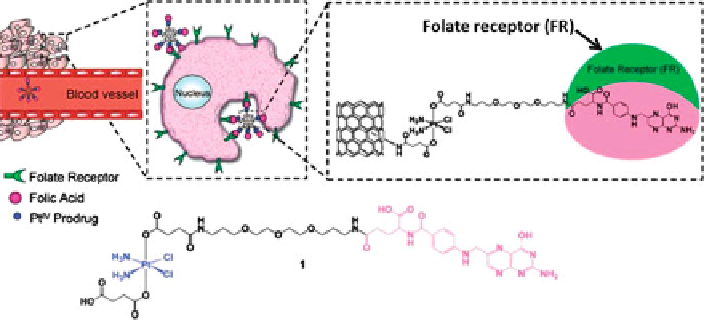Biomedical Engineering Reference
In-Depth Information
Fig. 11
Above
: Folate receptor-mediated targeting and SWNT-mediated delivery of structure 1
by endocytosis.
Below
: Structure 1. (Adapted from [
60
]).
6.3 Metal Nanoparticles
Faraday, in the mid-nineteenth century, contributed to the study of colloidal metal
particles. Turkevich and coworkers in 1951 synthesized and characterized “water-
soluble” gold colloids of size 18 nm [
62
]. Brust and coworkers reported metal
particles stabilized by alkanethiols [
63
,
64
]. Murray and coworkers [
65
] termed
these “monolayer-protected clusters” (MPCs), which could be redissolved in com-
mon solvents without decomposing or aggregating. MPCs are synthesized using a
bottom-up approach from a small number of building blocks. Gold MPCs can range
in size from 1 to 10 nm, containing approximately 55-1,000 gold atoms with
molecular weights between 10 and 200 kDa. Metallic nanoparticles such as Ag,
Au, and Pt have been synthesized by researchers for several centuries. Because of
their excellent optical properties, metallic nanoparticles are especially useful for
biomedical applications such as optical contrast agents, multimodal sensors com-
bining optical imaging and scattering imaging, and photothermal therapy. Figure
13
shows the UV-vis spectrum of solutions of gold nanoparticles capped with
octadecylamine-bis(2-ethylhexyl)-sulfosuccinate (ODA-AOT), and the effect of
capping agent concentration on the spectrum.
Water solubility of MPCs is best accomplished by using a thiolated, polar-
protecting ligand in a modified Brust reaction. In the Brust reaction,
tetrachloroauric acid is reduced from Au
3+
to Au
1+
in the presence of the thiol
capping ligand, yielding a colorless gold-thiol solution. This is either composed of a
gold-thiol polymer or tetramer. Following the initial reduction, the gold is further
reduced to Au
0
in the presence of sodium borohydride (NaBH
4
), yielding a black to
dark brown solution. Other potent reducing agents, such as lithium aluminum
hydride (LiAlH
4
) or lithium triethylborohydride, have been used to reduce different
metal cores such as palladium and platinum.

